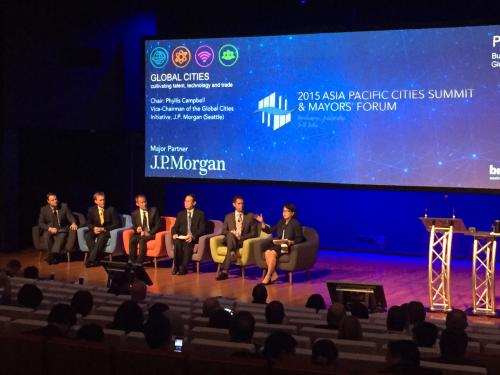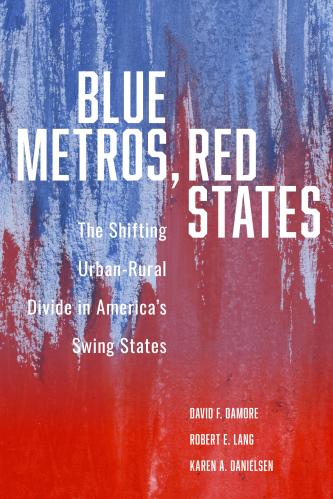Each week this summer a Brookings expert will post a blog related to one of the ten traits of globally fluent metro areas. These traits have proven to be particularly strong determinants of a metro area’s ability to succeed in global markets, manage the negative consequences of globalization, and better secure its desired economic future. This blog represents trait 8 – Ability to Secure Investment for Strategic Priorities.
All metro areas routinely depend on capital investment for important local upgrades. Beyond creating working public assets, this investment is also the key to how metro areas adjust to new requirements and opportunities. Whether it is a subway extension, a groundbreaking research institute, better public spaces, or increased housing supply, investment is the tool that supports growth and change. In so doing it remains a critical catalyst for metros seeking to achieve fluency in global markets.
With public funds at all levels becoming either scarcer or less predictable, metro areas must be flexible enough to assemble deals from a wide variety of public and private sources. In addition to, or perhaps in lieu of, strong local taxes, large transfer payments or easy debt financing, metro areas must increasingly pay attention to institutional and private investors, new financial instruments, and specialized fund managers.
Case in point is Miami, where after financing issues in 2008-2009, regional and state leaders have since assembled three key investments in the region’s port infrastructure to prepare for the widening of the Panama Canal. A new Bay Tunnel, a deep dredge project, and the Intermodal Rail Reconstruction Project exemplify how sub-national leaders are financing transformative infrastructure that blends multiple public and private funding sources.
Today, much more investment capital in metro areas comes from global sources. This capital is allocated through competitive processes that weigh different locations and asset classes against one another. Globally oriented metro areas have a better chance of attracting capital because they offer both public and private investors compelling development strategies with the attentive leadership to achieve them.
To attract investors, local leaders must pay special attention to how investment is facilitated and managed. There are three main elements to the investment platform that metro leaders can help synchronize with sound oversight:
-
- A public finance system of taxes, transfers, levies, charges, and loans that delivers enough investment to cover core public goods, services, and assets and also creates an effective structure of incentives and opportunity for private sector co-investment.
-
- Solid opportunities for global commercial and institutional capital providers to find ready investments. These can be organized to make appraisal simple and provide both a stable and dynamic environment for asset performance.
-
- Dynamic markets, ease of access, and a business-friendly climate that draws corporations and small- and medium-sized businesses into the region.
Some metro areas have been able to leverage public finances to become more globally engaged. In the 1990s, Brisbane had a poor record of attracting investment because of a lack of financial services and a limited culture of partnership with the private sector. But its consolidated (single tier) metropolitan council has been able to use its growing financial capacity—thanks to commodities tax revenues—to guide economic development and urban renewal.
Being an “investment ready” metro region means being able to leverage public finances, capital allocations, and corporate location decision making to create a positive cycle of capital flow. In Brisbane’s case, the council has convinced the Queensland state government to prioritize Brisbane for transport infrastructure funds, including for the Legacy Way toll road. Public-private partnerships have delivered the $3 billion Clem7 toll tunnel project, and the $5 billion Airport Link toll road. Brisbane has also overcome weak coordination in organizing incentives for small business and global firms and has committed to offering a resilient business environment and a reliable fiscal regime.
In a climate in which sovereign wealth funds, foreign pension funds, and other foreign investing vehicles have trillions in capital to invest, “investment-readiness” means deliberately preparing and packaging investment opportunities so they are easy to appraise. Brisbane has also been active in this respect; its city council subsidiary, Brisbane Marketing, successfully links local partners to international networks of digital, gastronomy, and logistics firms. The city’s economic development plan incorporates a thorough outreach agenda to Chinese, Japanese, and Malaysian resource firms amid an ongoing commodities boom, which will trigger new, diversified investments.
Metro areas must be open and ready to new channels of investment, including international institutional investors. Their leaders must integrate and promote both the potential internal rates of return to the investors and external rates of return to the region and its citizens, in order to motivate the shared commitment to enable such investments to succeed.










Commentary
The 10 Traits of Globally Fluent Metro Areas: Ability to Secure Investment for Strategic Priorities
August 19, 2013